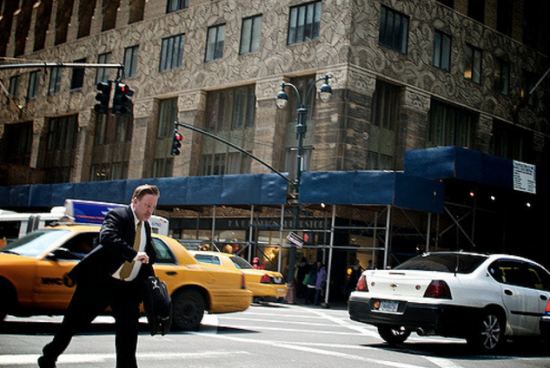
It’s not surprising that Massachusetts, the state where happy hour is illegal, has found a new way to legislate away one of the city’s greatest subversive small pleasures. For rushed urbanites especially, getting from place to place quickly on foot means crossing the street in the middle of the block. But State Senate Majority Leader Harriette Chandler has introduced legislation that would force pedestrians to adhere strictly to Cartesian space via stiff fines for jaywalking. This latest kerfuffle over the streets raises a question for inveterate jaywalkers and safety sticklers alike: What’s so wrong with jaywalking, anyway?
https://www.youtube.com/watch?v=qWGEPZlbtX4
Massachusetts’ current fine of $1, state officials claim, is hardly a deterrent to the common practice of crossing mid-block or against traffic. Chandler proposed a bill that would raise the fine for the initial offense to $25, $50 for the second, and $75 for the third jaywalk, The Boston Globe reports. (The standing law, enacted in 1962, imposes a $2 fine for the fourth offense and beyond.)
The bill was motivated by recent pedestrian deaths in the Worcester Democrat’s district. “It’s a bad habit we’ve all gotten into. And it’s changing a bad habit. And the best way to change a bad habit is to penalize it in some fashion,” Chandler testified to the Transportation Committee.
Since the rise of the automobile, government has taken an active role in dissuading citizens from crossing the street in the middle of the block, as the (totally catchy) ’60s PSA radio jingle explains. A jay, in early twentieth century parlance, was a rube, an unsophisticate. Calling someone a jay was a huge insult, as Adam Ruins Everything explains in the video above.
Interestingly, although humans have had legs for far longer than cars, the term “jay driver” preceded jaywalker. Before the first crosswalk was installed in 1911, cars, pedestrians, carriages, and streetcars had equal right to the street. Cars were viewed as menaces, and cars driven recklessly by so-called jay drivers were seen as a threat to the balance of chaos and control that kept the streets usable for all. Citizens were justified in reviling drivers: By the end of the 1920s, automobile accidents had killed more than 250,000 people.
As with the streetcar phase-out, the interests of the automobile-owning capitalist class prevailed over the public’s right to the street. The auto industry lobbied to make cars the prima donnas of the street, a mode of travel that deserved special protections from annoying pedestrians, especially. The American Automobile Association (AAA) spearheaded school safety campaigns, warning boys and girls of the dangers of jaywalking. In a few short years, the threat of cars to people was superseded in public discourse by the threat of people to cars: by the 1930s, most municipalities had enacted laws agains jaywalking.
These days, the jaywalking crackdown is not limited to Massachusetts. In 1998, New York City got tough on jaywalking, jacking up fines from $2 to $50. Under de Blasio, those fines went up to a maximum of $250. As with the enforcement of “quality of life crimes” like loitering and public drinking, jaywalking citations are primarily foisted on poor people of color.
As the Massachusetts legislature debates this bill, it’s worth re-engaging the old debate: is jaywalking a really crime, or is it just criminalized?